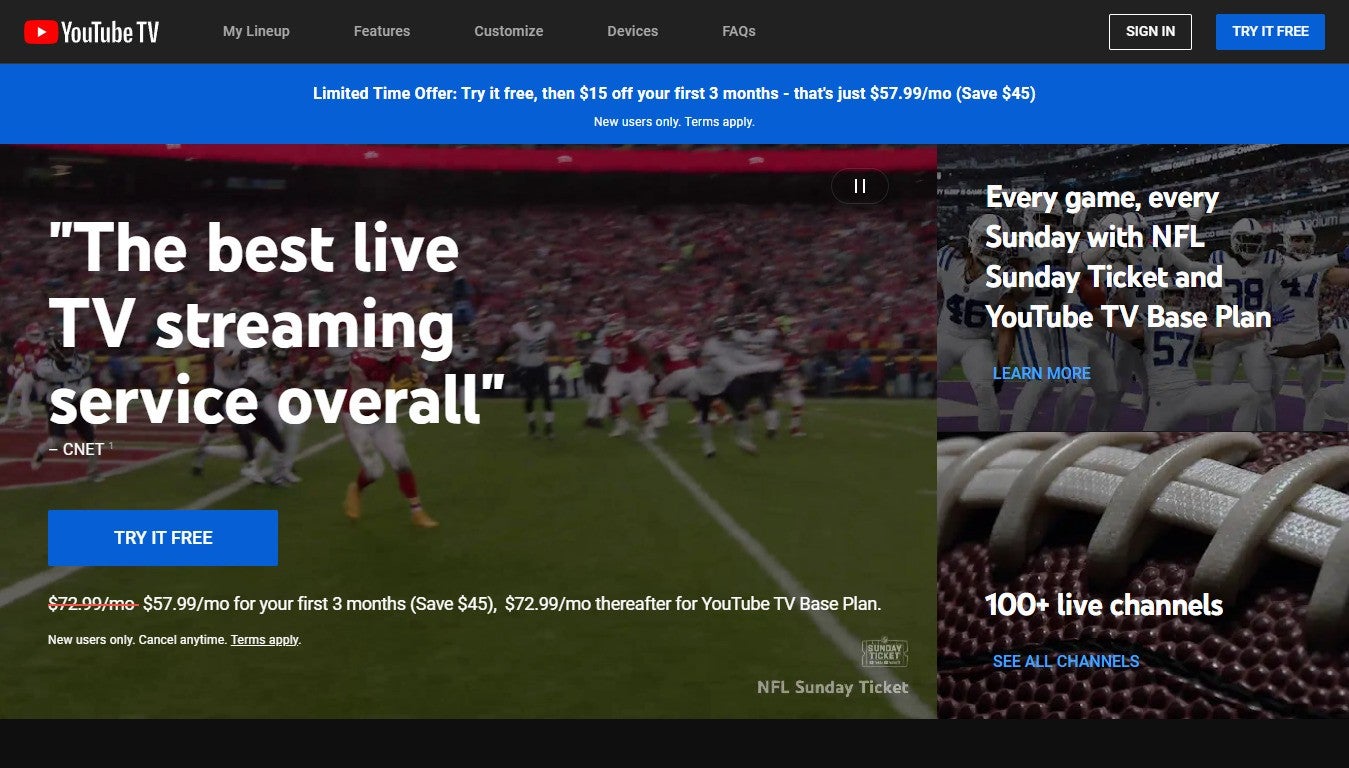When Will YouTube TV Become The Biggest Cable Channel Distributor in the United States?
YouTube already has more customers than big-name providers like DISH, and it’s worth asking when the streamer will have more customers than any pay-TV outlet.

Much like Thanos in “Avengers: Endgame,” YouTube TV feels inevitable. The live TV streaming service is the undisputed ruler of its market segment, boasting 8 million subscribers at last public disclosure. That’s almost twice as many as the next-closest competitor Hulu + Live TV, and it’s more than longtime stalwarts in the pay-TV distribution game like DISH and Altice. As broadband internet becomes more widely available, customers are increasingly comfortable cutting the cord and choosing nonlinear means to get their cable channels. But the questions remain, how is it that YouTube TV has managed to rise to the top, and how much higher can it climb? On its current trajectory, YouTube TV is a lock to become the largest cable channel distributor in the United States in relatively short order. Even giants like Comcast and Charter can’t stand in Google’s way for much longer, and by 2029 YouTube TV could be able to make the claim that it has killed cable once and for all.
Key Details:
- A pattern of long periods between price increases, a wide mix of channels, and a bevy of desirable features makes YouTube TV popular among consumers.
- The streamer added 3 million customers in less than two years, whereas top cable and satellite providers lost nearly 7 million in 2023 alone.
- Data shows that YouTube TV’s chances of overtaking DIRECTV, Comcast, and Charter within the next five years are quite high.
How Has YouTube TV Built Scale?

YouTube TV launched in February 2017, when it was available in just five markets: New York, Los Angeles, Chicago, Philadelphia, and San Francisco. Since then, the platform’s availability has spread throughout the United States, and its base plan includes 100+ channels depending on the market, including local affiliates of broadcast networks like ABC, CBS, Fox, NBC, and PBS in most areas.
YouTube’s parent company Google (and its parent company Alphabet Inc.) is notoriously secretive about the live TV streamer’s subscriber totals, so tracking the history of customer additions is a little tricky. Public updates from the company have been few and far between, but when going through the historical data, YouTube TV has shown a fairly steady growth rate.
| Year | Subscriber Total | % Increase |
|---|---|---|
| 2019 | 2 million | N/A |
| 2020 | 3 million | 50% |
| 2022 | 5 million | 66% |
| 2024 | 8 million | 60% |
In the past five years, YouTube TV has gained 6 million subscribers, with half of that total coming since July 2022.
So how has the live streamer managed to build such an impressive subscriber total? The biggest reason likely lies in the fact that YouTube TV’s price increases have been as infrequent as public reports about the size of its customer base. The platform last raised its prices in May 2023, when the cost jumped from $64.99 to $72.99 per month. That was YouTube TV’s first price increase since June 2020, however, following a three-year gap, an $8 per month increase is not as dramatic as it might otherwise appear. A comparison of similarly-priced competitors — DIRECTV STREAM, Fubo, and Hulu + Live TV — shows that each increased subscription rates by $21 or more ove the same period.
| Service | Price of Cheapest Plan in 2020 | Price of Cheapest Plan Today | Increase in Price Per Month |
|---|---|---|---|
| YouTube TV | $64.99 | $72.99 | $8 |
| DIRECTV STREAM (then AT&T TV Now) | $55 | $79.99 | $25 |
| Fubo | $64.99 | $91.98 ^ | $26 |
| Hulu + Live TV | $54.99 | $75.99 ^^ | $21 |
^indicates price of Fubo Pro plan with regional sports network fee of at least $11.99 per month.
^^indicates cheapest possible plan of Hulu + Live TV with no Disney Bundle access.
A large and seemingly ever-increasing array of features has also been helpful in YouTube TV’s quest to add customers. The platform's multiview function for watching college and pro sports, as well as limited news and entertainment programming, has been hugely popular. YouTube was far from the first to market with a multiview feature; streamers like Fubo and the now defunct PlayStation Vue have also used the feature, but always limited to specific devices. YouTube TV first harnessed the power of the capabilities during the 2023 NCAA March Madness Tournaments and has been refining and expanding the feature ever since. YouTube TV is constantly tinkering with the function to help improve the customer experience, and its regular updates and expansions have resonated with fans.
Even when considering YouTube TV pulled just a reported 1.3 million subscribers to NFL Sunday Ticket in 2023 — its first season as the ot-of-market package’s exclusive home — it points to another reason that customers are so fond of YouTube TV: Choice. The service offers myriad add-on subscriptions like Sunday Ticket, Max, NBA League Pass, Paramount+ with SHOWTIME, and more through the Primetime Channels hub, which does not require a YouTube TV subscription to use. Best yet, customers get one of the most requested options in streaming: a hub that manages all of their subscriptions and keeps them on the same monthly bill.
All of this has led to a YouTube TV customer base that is not only large, but also largely satisfied. In fact, an October 2023 report from J.D. Power found that YouTube TV scored higher in customer satisfaction than any other live TV streaming service, cable provider, or satellite company on the market. The service scored 795 points out of a possible 1,000, and while there’s still clearly room for YouTube TV to grow, it outstripped its competitors by a considerable margin.
Click images to enlarge. Graphics courtesy of J.D. Power.
When Will YouTube TV Have More Subscribers than Charter, Comcast, and DIRECTV?

Recent data compiled by Leichtman Research Group indicates that YouTube TV already has more subscribers than all but the three biggest names in pay TV: Comcast, Charter, and DIRECTV. As of the end of 2023, Charter had 14.122 million subscribers, just a hair more than Comcast’s 1.4106 million. DIRECTV has 11.3 million viewers on its satellite and internet services, DIRECTV STREAM, DIRECTV via Internet, and AT&T U-Verse.
| Distributor Name | TV Subscribers at the end of 2023 | Gains/Losses in 2023 |
|---|---|---|
| Charter | 14,122,000 | -1,025,000 |
| Comcast | 14,106,000 | -2,036,000 |
| DIRECTV | 11,300,000 | -1,800,000 |
| YouTube TV | 8,000,000 | + 1.5 million (estimate) |
| DISH TV (DBS) | 6,471,000 | 945,000 |
| Hulu + Live TV | 4,600,000 | + 100,000 |
| Sling TV | 2,055,000 | -279,000 |
| Verizon Fios | 3,012,000 | -289,000 |
| Fubo | 1,618,000 | +173,000 |
| Frontier | 234,000 | -72,000 |
Data courtesy of Leichtman Research Group.
If YouTube TV maintains a growth rate of 1.5 million subscribers per year as it has since 2022, it will have 12 million subscribers by 2026. That’s the expansion rate expected by market research and analysis firm MoffettNathanson, which recently forecast that YouTube TV would show a modest profit this year. Suppose YouTube TV does add the projected 1.5 million subscribers annually while traditional pay-TV competitors lose customers at the same rate that they did in 2023. In that case, the Google-owned streamer will be the largest cable channel distributor by 2026.
There, of course, could be complicating factors that delay YouTube’s rise to the top of the pay-TV world. One X-factor that could break in cable’s direction is the advent of carriage deals that offer subscription video streamers at no extra cost. Charter Communications struck a deal with Disney in September that gave the company’s Spectrum TV subscribers free access to their own Disney+ accounts, as well as access to ESPN+ for some viewers. Leichtman’s data shows that Charter still lost 1 million customers over the course of the year, but the Disney deal may have convinced some to stay. Comcast struck no such carriage deals in the course of the year, and its losses nearly doubled those of Charter, dropping it to second in terms of U.S. pay-TV subscribers.
Could other cable distributors negotiate something similar with streaming providers? It’s certainly possible, as companies like Paramount have made it known that their streaming services are open to such deals. These types of agreements can benefit both the distributor and the streamer; cable companies get to add value to their product, and may be allowed to drop some channels that are no longer pulling their viewership weight as well. Streamers get a new bundle of subscribers, and while the Spectrum/Disney pact pays Disney a wholesale price for the customers who sign up for Disney+ accounts, those customers are being placed on its ad-supported Basic tier, which means that the company gets to collect ad revenue for them as well.
If more carriage deals like the Disney and Charter accord come to fruition, it could mean that cable company losses slow somewhat. Still, if YouTube TV keeps adding 1.5 million subscribers per year as MoffettNathanson forecasts each year until 2029, it will end up with 15 million subscribers. That would be more than every major linear cable or satellite provider in the United States has in 2024, and unless those platforms start to gain subscribers in defiance of their current trajectories and industry logic, that will leave YouTube TV as the biggest channel distributor in the country.
One final threat to YouTube TV’s ascendence looms, the joint venture sports streaming service set to launch from Disney, Fox, and Warner Bros. Discovery in fall 2024. This service will offer complete streams of 14 total channels, including ABC, ESPN, Fox, FS1, TNT, TBS and more. The fact that this service is so sports-focused likely makes it more of a threat to Fubo than it does to YouTube TV, which maintains a balance of news, sports, and entertainment offerings. However, as demonstrated with the NFL Sunday Ticket and multiview inclusions, YouTube TV has long positioned itself as a streaming destination for sports fans. If the yet-to-be-named sports joint venture survives inquiries from Congress and the Department of Justice, as well as an anti-trust lawsuit initiated by Fubo, the skinny sports bundle could siphon off some of YouTube’s subscriber base.
If the Disney, Fox, and WBD service does eventually pass muster, more channel-owning companies could decide to start offering all sorts of miniaturized bundles of 20 networks or less built around a common theme like movies or animation. If that is the future of streaming, larger, more expensive services like YouTube TV may lose customers who prefer an experience closer to a la carte channel selection.
Despite all of the caveats and hypotheticals, all data points in one direction for cable companies, and it’s not the way that they want things to go. Rising carriage fees lead to increasing subscription rates, which leads to more customers seeking a new way to watch their favorite channels for less. YouTube TV will continue to pick up its fair share of those consumers, and by 2026 it could surpass even the largest channel distributors in terms of subscribers. Yes, there could be stumbling blocks in the streamer’s path, but it seems inevitable that YouTube TV will surpass Comcast, Charter, and DIRECTV to become the largest cable channel distributor in the United States by 2029, if not sooner.
YouTube TV
YouTube TV is a live TV streaming service with more than 60 channels for $72.99/month. This plan includes local channels, 32 of the top 35 cable channels, and regional sports networks (RSNs) in select markets. The service includes an unlimited DVR.



